between the peoples of the Mackenzie and the Lena delta, and it is not improbable that the carrying band of the Ainu in Yeso and a similar device depicted on ancient codices and stone monuments in Mexico may have had a common origin. Advancing to a time when man acquired the art of recording his thoughts, the question of anycontact between the peoples of the eastern and western shores of the Pacific, south of latitude 40°, compels us to examine the avenues which have been so potent in the distribution of life in the past—namely, the oceanic currents. We are at once led to the great Japan current, the Kuro Shiwo, which sweeps up by the coast of Japan and spends its force on the northwest coast of America. Records show a number of instances of Japanese junks cast ashore on the Oregon coast and shores to the north.[1]
It must be evidences of Japanese and not Chinese contact that we are to look for—tangible evidences, for example, in the form of relics, methods of burial, etc. That the Japanese bear resemblances to certain northern people there can be no doubt. Dr. Torell brought before the Swedish Anthropological Society, some years ago, the results of a comparative study of Eskimo and Japanese. The anatomical and ethnographical resemblances appeared so striking to him as to give additional strength to the theory of the settlement of America from Asia by way of Bering Strait. That there are certain resemblances among individuals of different races we have abundant evidences. At a reception in Philadelphia I introduced a Japanese commissioner (who had been a Cambridge wrangler) to a full-blooded Omaha Indian dressed in our costume, and the commissioner began a conversation with him in Japanese; nor could he believe me when I assured him that it was an Indian that he was addressing, and not one of his own countrymen. I was told by an attaché of the Japanese legation at Washington that after carefully scrutinizing the features of a gentleman with whom he was traveling he ventured to introduce himself as a fellow-countryman, and found to his astonishment that the man was a native of the Malay Peninsula. That the Malays bear a strong resemblance to the Chinese is quite true. Dr. Baelz, of the Medical College of Japan, can find no differences between the crania and pelves of the Chinese and Malays. Wallace assures us that even the Malay of Java, when
- ↑ Mr. Charles Walcott Brooks presented to the California Academy of Sciences a report of Japanese vessels wrecked on the North Pacific Ocean in which many instances are given. He says: "Every junk found stranded on the coast of North America or on the Hawaiian or adjacent islands has, on examination, proved to be Japanese, and no single instance of a Chinese vessel has ever been reported, nor is any believed to have existed. . . . There also exists an ocean stream of cold water emerging from the Arctic Ocean which sets close in along the eastern coast of Asia. This fully accounts for the absence of Chinese junks on the Pacific, as vessels disabled off their coast would naturally drift southward."
